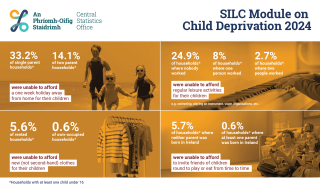Child Deprivation in Ireland: Single-parent and renter households disproportionately affected

The latest release from the Central Statistics Office (CSO), detailing the 2024 Survey on Income and Living Conditions (SILC) module on Child Deprivation, presents a sobering snapshot of life for too many children in Ireland. In 2024, 13.8 per cent of children were identified as living in child-specific enforced deprivation, an increase from 12.6 per cent in 2021. This means that nearly one in seven children lack at least three essential items or experiences deemed necessary for their development and wellbeing. These findings reaffirm what we have consistently highlighted: a significant number of children are being left behind by systems that are failing to protect and support them.
Key findings
One in eight (12.1 per cent) single-parent households were unable to afford regular leisure activities (e.g. swimming, playing an instrument, youth organisation membership) for their children.
- One in twenty (5.6 per cent) households who rented were unable to afford new clothes for their children, compared with 0.6 per cent of owner-occupied households.
1.8 per cent of households with children reported that they could not afford school trips or school events that cost money. The rate for single-parent households was 10 times higher than the rate for two-parent households (6.2 per cent and 0.6 per cent respectively)
5.7 per cent of households without an Irish-born parent could not afford to invite friends of their children round to play or eat from time to time, compared with less than 1 per cent of households with at least one Irish-born parent.
One in three (33.2 per cent) households in rented accommodation could not afford a one-week holiday for their children, four times higher than the rate for owner-occupied households (8.6 per cent).
In 2024, nearly one in six children (15.3 per cent) lived in households that were below the poverty line, and 262,700 children lived in households experiencing deprivation. These figures reveal structural injustices rooted in housing, employment, and inadequate social welfare. Fundamentally, child poverty and deprivation cannot be separated from the poverty experienced by the families to which children belong. Child poverty solutions hinge on issues such as adequate adult welfare rates, decent rates of pay and conditions for working parents, and adequate and available public services. Child benefit also remains a key route to tackling child poverty. It is of particular value to those families on the lowest incomes.
Policy recommendations for Government:
- Benchmark core social welfare rates to 27.5 per cent of average weekly earnings in 2025 as a first step towards indexing social welfare rates against wages.
Acknowledge that Ireland has an on-going poverty and deprivation problem.
Adopt targets aimed at reducing poverty and deprivation among particular vulnerable groups such as children, lone parents, jobless households and those in social housing.
Recognise the problem of the ‘working poor’. Make tax credits refundable to address the situation of households in poverty which are headed by a person with a job.
Support the widespread adoption of a Living Wage so that low paid workers receive an adequate income and can afford a minimum, but decent, standard of living.
Introduce a cost of disability allowance to address the poverty and social exclusion of people with a long-term illness or disability.
Recognise the reality of poverty among migrants and adopt policies to assist this group. In addressing this issue, replace direct provision with a fairer system that ensures adequate allowances are paid to asylum seekers.
Accept that persistent poverty should be used as the primary indicator of poverty measurement and assist the CSO in allocating sufficient resources to collect this data.
Examine and support viable, alternative policy options aimed at giving priority to protecting vulnerable sectors of society.
Carry out in-depth social impact assessments prior to implementing proposed policy initiatives that impact on the income and public services that many low income households depend on. This should include the poverty-proofing of all public policy initiatives.
Introduce a universal basic income system. No other approach has the capacity to ensure all members of society have sufficient income to live life with dignity.
Acknowledge the failure to meet repeated policy targets on poverty reduction and commit sufficient resources to achieve ambitious and credible new targets.